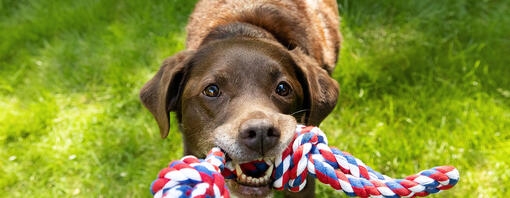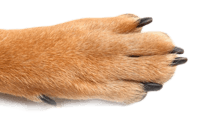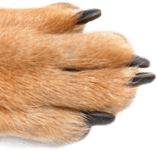
No matter how careful we are and how much we watch our puppy, there will be times when they pick up something they shouldn’t have. Knowing how to deal with these situations and how to get your puppy to give things back safely and effectively can prevent them damaging valuable items, eating things that are potentially dangerous, or learning to guard their ‘prizes’.
What Is The ‘Leave It’ and Drop It’ Command: Are They the Same?
‘Drop it’ is when we need our dogs to let go of something that they have got in their mouth – this could be something they shouldn’t have, or it could be a toy that they don’t want to let go of.
‘Leave it’ is used when we want our dogs not to pick something up in the first place.
Both of these are important life skills to learn to enable you to keep your dog safe from eating or chewing dangerous or toxic items, to be able to take back things that are valuable, and to prevent resource guarding.
Why Do Dogs Pick Up Things They Shouldn’t Have?
Dogs, especially puppies, are inquisitive and keen to explore things in their environment. This is an important part of their development and is how they learn about their world and become familiar with things in their new home.
Puppies have very limited ways to investigate new things however – and while one is scent, the other is by putting them in their mouths.
Many of our most popular breeds were originally developed as gundogs – and this includes Labradors, retrievers, and all the many spaniels (and their crosses). These were dogs that were developed to be extremely mouth-oriented, as they were purpose-bred to be experts at finding, picking up, carrying and retrieving fallen game. As humans, we have historically encouraged and bred dogs who were experts at this natural instinct, so we can hardly be surprised that our modern dogs retain the same enthusiasm for finding and carrying things they find in their environment.
Plus, dogs as a species have developed opportunistic scavengers so it’s always worth checking to see if something is tasty!
And if that thing is tasty, makes a fun noise, feels good to chew, or smells great, that is going to be immediately rewarding and so the behaviour is further reinforced.
How To Stop Puppies Picking Up Things They Shouldn’t
First of all, be aware that this is a natural instinct and part of a puppy’s development – it is not them being ‘bad or destructive. It is up to you to manage their environment so that the only things that the puppy can find and pick up are appropriate toys – and make sure they have plenty of these of different types, textures and shapes.
Tidy other things away – or put them out of your puppy’s reach. Use baby gates to keep them out of rooms where there are ‘chewables’, or where there are objects that are valuable or dangerous and supervise them or use a play pen when you are relaxing at home with them.
With good management, there should be few things in your puppy’s environment at this developmental time while they are at their most inquisitive and exploratory that they can pick up that isn’t theirs and safe.
And you will be giving them lot of enrichment opportunities to find and interact with all kinds of different toys to fulfil their mental and physical developmental needs, so they are less likely to explore things that are less interesting.
Drop It - Teach Your Puppy to Swap
From the very beginning of your life with your puppy or dog, it’s important to teach them how to give up toys by swapping them so they always think they are getting something better.
- When you are playing, have two toys the same so that when you are throwing them for your puppy to chase or else playing gentle tuggy type games, you can regularly ignore the one your puppy has and make the one you’ve got seem more valuable by making it ‘come alive’ by wiggling it around, squeaking it etc so that your puppy drops the one they’ve got in favour for the one you have. As they do so, say “drop” or “leave” to link the word with the action.
- Your aim is to ensure that your puppy looks forward to giving up their ‘prize’ because you will give them something better. The more times you do this in play, the more likely it is that your puppy will give up things that they shouldn’t have in the future.
- This can be done on walks and when you are out and about too. Take two identical toys with you and swap between the two.
Teaching Drop It Without Swapping
Once your dog can happily swap toys, you can teach the ‘drop it’ exercise for a reward only.
Equipment needed:
- A toy your dog likes playing with
- Tasty dog treats (ideally smelly)
- Treat bag
- Play with a toy in the same way as you have been doing.
- When you decide you want to take the toy back, stop the game (so the toy becomes boring) and show your dog the tasty treat.
- When they let go of the toy to take the treat, say “Drop”.
- Practise this a lot in different environments and with different toys
- When they can do this reliably, the next step is to ask them to “Drop” using the cue work only. When they do, reward them with the treat.
How To Teach a Dog To leave It
Teaching your puppy to ‘leave it’ and so not pick something up in the first place can be an important exercise to teach.
It can prevent them from picking up things while they are out on a walk, keep them away from dangerous situations, stop them interacting with people that do not like or are scared of dogs, or grabbing dropped food or hazardous objects in the house.
It is a good exercise for teaching impulse control and even can stop your dog snatching treats from your hand.
Equipment needed:
For this exercise you need two types of treats. Boring ones and high value ones. The boring ones will be held in your hand and the high value ones will be in a treat bag or your pocket.
- Sit with your puppy (on the floor if you dog is small) with a boring treat in your closed hand.
- Let them sniff at your hand and even paw at it. Don’t say anything, just keep your hand closed.
- Wait for them to stop trying to get to the treat or just take their nose away for an instant.
- The moment they do use your marker word (or clicker if you use one) and reward them with a high value treat from your other hand.
- Repeat several times until your puppy automatically backs up when you hold out the hand with the treat in it.
This is laying the groundwork for “leave it” by teaching your puppy that leaving something tempting brings better rewards.
Now repeat the same exercise with a treat on the ground and your hand covering it palm downwards.
Next steps - Add the Cue Word.
Once your puppy can do this reliably, you can introduce the verbal cue. As your puppy backs away from the boring treat, say “Leave It” – and then reward as before with the marker word and the high value reward.
The next step is to have the boring treat in your open hand – always being quick to close your fingers around the treat if the temptation becomes too much for your puppy!
Keep practising until your puppy or dog can ignore the treat when you tell them to Leave’ - even when it is in plain sight.
Practise this in different rooms and different places until you are confident that your dog will ignore a treat when you say, “Leave It”.
Training Your Dog to Ignore Distractions
You can play games with your dog using this exercise by putting a fairly boring toy and treat on the ground and getting your dog to walk past it is using a combination of your ‘watch me’, ‘loose lead walking’ and ‘leave it’ cues. When they do, give them a tasty reward and a game (if they are toy oriented).
Start on lead – and work up to doing it off lead.
You can build this game up to having several treats and toys in two lines that they walk between.
This is all building up your dog’s training and improving your handling skills so you can be successful in this exercise at the times when you need it.
How To Manage High-Temptation Environments
When you are out and about however, be realistic. Something new that looks or smells overwhelmingly tempting can be impossible to resist – especially for greedy dogs (such as Labradors), so this is where staying alert to your environment and keeping your dog under close control is important. If you are walking places where there is a high likelihood of picking up undesirable things (sheep or horse poo – or raiding picnics), consider using a basket type muzzle.
What Not to Do When Teaching Leave It and Drop It
No matter what your puppy has picked up, do not chase them to get it back. In a puppy’s mind, this is a great fun game of chase – and is similar to games they will have played with their littermates. Instantly you make the thing they’ve got really valuable in their mind (because you obviously want it so much!) and so of course they will run away.
Also don’t shout at them, grab them – or tell them off. The mistake is yours for leaving things lying around but more importantly, this is likely to teach them to guard the things they steal and their toys – especially in those breeds and types that can be prone to resource guarding behaviours.
No matter how valuable the item is, keep your voice exactly the same as when you have been practising ‘leave it’ in training. Your dog learns your tone of voice as much as the words you say.
Don’t try to get the item back by grabbing or tugging at it – that just makes it another fun game!
When you are out and about, stay focused on your dog – and stay alert to things in your environment that might be tempting for your dog. It is far better to distract your dog from something you think they might be likely to pick up or attempt to eat than it is to get them to leave it or drop it.
Teaching a dog to drop things is something you introduce and practise daily when you are playing with your puppy or dog. This is an important life skill – and makes games with your dog more enjoyable. It also improves the bond and the trust between you – and means that in an emergency, you have already taught your dog how to drop things and give them back to you.
NOTE: If your dog or puppy guards items that they have stolen or resources they have (food, toys etc), consult an accredited behaviourist for help as this can lead to aggression.





